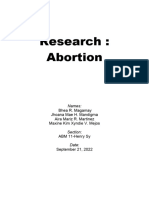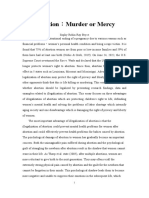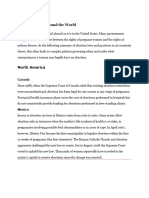0% found this document useful (0 votes)
85 views18 pagesChapter 1
The document discusses the history and legal status of abortion in multiple locations around the world. It begins by covering the history and legal battles around abortion in the United States, including Roe v. Wade and recent restrictions passed in various states. It then discusses abortion laws and restrictions in other countries worldwide, including bans, exceptions for life/health of the mother, and reasons permitted. The document concludes by specifically covering the ban and criminalization of abortion under Philippine law.
Uploaded by
Tirso CruzCopyright
© © All Rights Reserved
We take content rights seriously. If you suspect this is your content, claim it here.
Available Formats
Download as DOCX, PDF, TXT or read online on Scribd
0% found this document useful (0 votes)
85 views18 pagesChapter 1
The document discusses the history and legal status of abortion in multiple locations around the world. It begins by covering the history and legal battles around abortion in the United States, including Roe v. Wade and recent restrictions passed in various states. It then discusses abortion laws and restrictions in other countries worldwide, including bans, exceptions for life/health of the mother, and reasons permitted. The document concludes by specifically covering the ban and criminalization of abortion under Philippine law.
Uploaded by
Tirso CruzCopyright
© © All Rights Reserved
We take content rights seriously. If you suspect this is your content, claim it here.
Available Formats
Download as DOCX, PDF, TXT or read online on Scribd
/ 18






























































